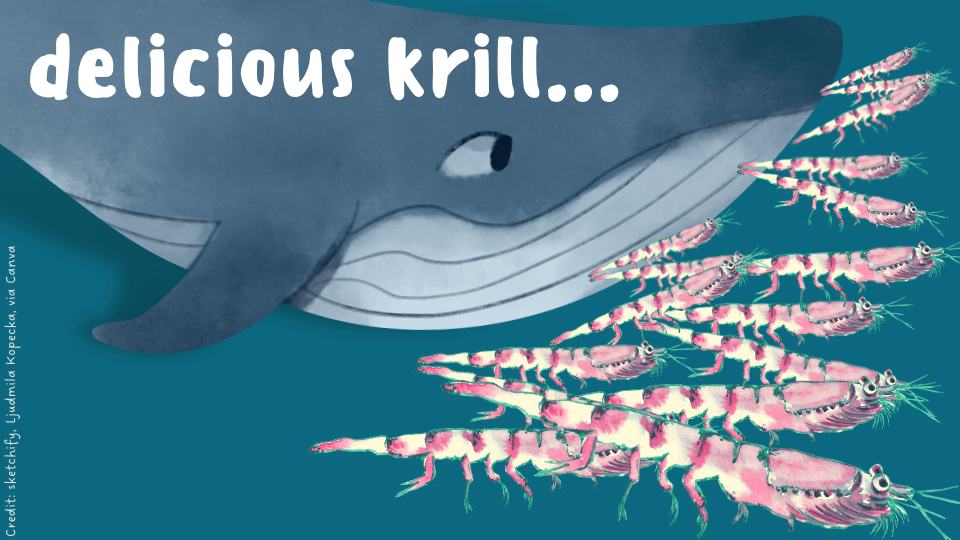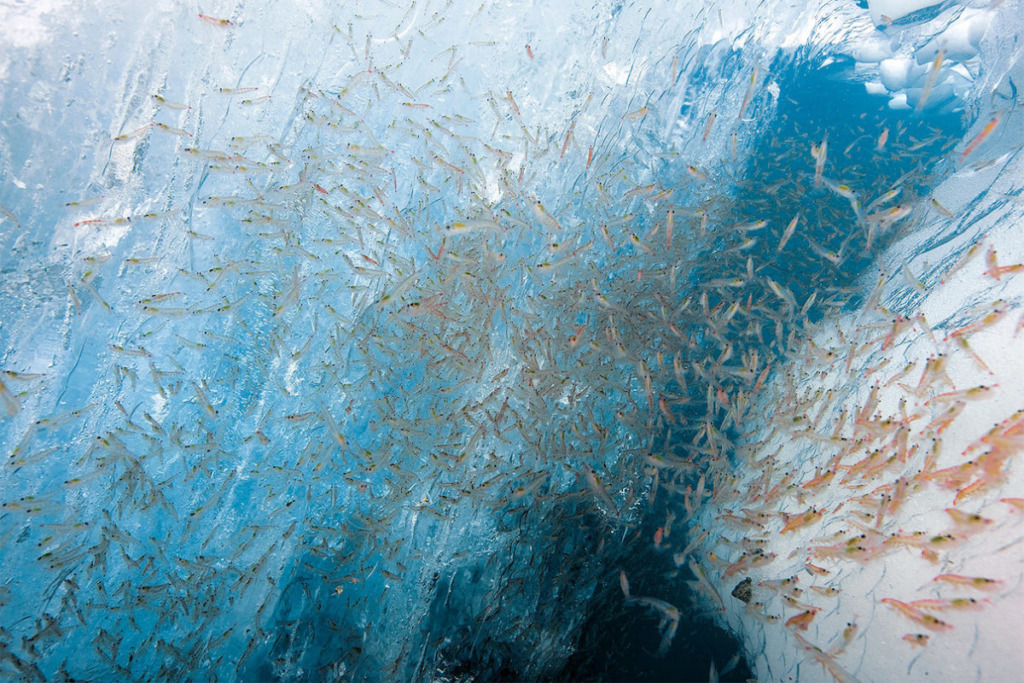BIOMASS is the total mass of organisms in a given area. What wild animal has the highest biomass on Earth, and where would you look for it?
Is it the flies in the skies? Nope, look lower. Is it the billions of humans running around the lands? Nope! Look lower. Hint: you have to get wet and cold.
Krill are estimated to have the highest biomass of any multicellular wild animal on Earth. There are more Antarctic krill by mass than just about any other animal. A 2009 study estimated that Antarctic krill have a biomass of between 300 million and 500 million metric tons. (1 metric ton = 1000 kilograms.) By comparison, humans are estimated to have a biomass of around 300 million metric tons.

So, what are krill?
Krill are tiny crustaceans – they are cousins of shrimp, lobsters, and crabs. They live in all of the oceans of the world, but they are super-abundant in the Southern Ocean around Antarctica.

There are several reasons we should thrill to the krill, or get excited about krill.
Antarctic krill are extremely important players in the Southern Ocean ecosystem. They are the main food of baleen whales. Krill are an important part of penguin, seal, and fish diets too.

Krill are also important because of the role they play in carbon storage. Krill help take out some of the carbon dioxide from Earth’s atmosphere that humans put into it. How does this work?
Krill eat a lot of phytoplankton. Phytoplankton are tiny plants in the oceans that produce most of the oxygen we breathe. Phytoplankton take carbon dioxide from the atmosphere when they convert sunlight into energy. Phytoplankton store carbon, like trees or other plants.
When krill eat the phytoplankton and poop out the remains, some of this carbon sinks to the seafloor.

Why should we care about how much carbon krill poop? Gross! We should care because they poop A LOT OF CARBON!
One study estimates that krill remove 23 million metric tons of carbon each year from the atmosphere. Honk if you want to know how much carbon that is.
Even if you didn’t honk, we’ll tell you. Krill remove as much carbon as is produced by 35 million cars!

Because there are so many krill, people once thought that they were a limitless resource that could be used forever. We now know that Antarctic krill are a finite (limited) resource. Krill are under an increasing amount of pressure due to overfishing, pollution, and climate change impacts.
The Commission for the Conservation of Antarctic Marine Living Resources (CCAMLR) is a group responsible for protecting krill. They have imposed rules to try and regulate krill fishing in the Southern Ocean. Krill fishing has increased every year as demand rises for the tiny crustaceans.

Krill are used as feed additives for global aquaculture (the farming of marine and freshwater organisms like fish). Krill are also processed for oil, which contains omega-3 fatty acids used in some dietary supplements.
Some conservationists and scientists are proposing that three marine protected areas should be established in East Antarctica, the Antarctic Peninsula and the Weddell Sea. These marine protected areas would help krill by protecting some of their main breeding areas. There would be no fishing pressure on the krill in these areas.

People who care about krill have different opinions about how to manage the krill fishery. Krill experts tend to agree on one thing though: krill are too valuable to lose in this moment of climate crisis.
Krill expert Kim Bernard explains why krill are important to climate change: “Even though Antarctic krill are seemingly far removed from our lives, some of that excess carbon dioxide we’ve pumped into the air is exported to the sea floor by krill, where it will remain for thousands of years. Without Antarctic krill, Earth would be even hotter than it already is.”
Additional resources for parents & educators
Frontiers for Young Minds: Why Krill Swarms Are Important to the Global Climate
The Conversation: How Antarctic krill fertilise the oceans and even store carbon – all with their poo


